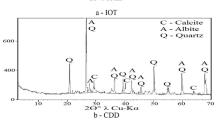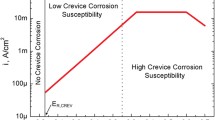Abstract
The selection of suitable materials to construct a facility for the final disposal of radioactive wastes (repository) is a challenge in materials science, since these facilities must be designed to provide confinement to the radionuclides for long periods of time. In the case of the low-level radioactive waste (LLRW) repository, the confinement of the species must be guaranteed for more than 300 years. In this context, the evaluation of the proposed materials must be performed under accelerated laboratory tests. One type of LLRW consists of ashes that result from the incineration of solid combustible radioactive waste. In Argentina, one of the proposed projects is to place these ashes inside steel drums and immobilized them by a cementation process. The issue to be resolved is whether the steel drums will undergo internal corrosion depending on the presence of certain deleterious species. The aim of the present work is to evaluate the corrosion susceptibility of steel drums containing simulated cemented incineration ashes. To this purpose, a special type of specimen was designed and the corrosion process was followed up for almost 4 years. It was found that, although the deleterious effect of chloride is undeniable, corrosion rates are not as high as to compromise the integrity of the steel drums for a design period of 300 years.










Similar content being viewed by others
References
G.S. Duffó, E.A. Arva, F.M. Schulz, and D.R. Vázquez, Durability of a Reinforced Concrete Designed for the Construction of an Intermediate-Level Radioactive Waste Disposal Facility, J. Nucl. Mater., 2012, 420, p 382–387
R.O. Abdel Rahman and A.A. Zaki, Assessment of the Leaching Characteristics of Incineration Ashes in Cement Matrix, Chem. Eng. J., 2009, 155, p 698–708
V.M. Efremenkov, Radioactive Waste Management at Nuclear Power Plants, IAEA Bull., 1989, 4, p 37–42
A.E. Osmanlioglu, Progress in Cementation of Reactor Resins, Progr. Nucl. Energy, 2007, 49, p 20–26
M.S. Sayed and M.M. Khattab, Immobilization of Liquid Radioactive Wastes by Hardened Blended Cement-White Sand Pastes, J. Am. Sci., 2010, 6, p 334–341
F.P. Glasser, Progress in the Immobilization of Radioactive Wastes in Cement, Cem. Concr. Res., 1992, 22, p 201–216
J.D. Palmer and G.A. Fairhall, Properties of Cement Systems Containing Intermediate Level Wastes, Cem. Concr. Res., 1992, 22, p 325–330
M.L.D. Gougar, B.E. Scheetz, and D.M. Roy, Ettringite and C-S-H Portland Cement Phases for Waste Ion Immobilization: A Review, Waste Manag., 1996, 16, p 295–303
Caracterización de cenizas radioactivas simuladas y evaluación de métodos de acondicionamiento (Characterization of Simulated Radioactive Waste Ashes and Evaluation of Conditioning Methods), Technical Report IP/IQ-001-262/89, Departamento de Ingeniería Química y Ambiental, Escuela Superior de Ingenieros Industriales de Sevilla, Sevilla, 1991 (in Spanish)
G.S. Duffó, S.B. Farina, F.M. Schulz, and F. Marotta, Corrosion Susceptibility of Steel Drums Containing Cemented Intermediate Level Nuclear Wastes, J. Nucl. Mater., 2010, 405, p 274–279
G.S. Duffó, S.B. Farina, and F.M. Schulz, Corrosion of Steel Drums Containing Cemented Nuclear Waste, J. Nucl. Mater., 2013, 438, p 116–125
G.S. Duffó, S.B. Farina, and C.M. Giordano, Characterization of Solid Embeddable Reference Electrodes for Corrosion Monitoring in Reinforced Concrete Structures, Electrochim. Acta, 2009, 54, p 1010–1020
G.S. Duffó, S.B. Farina, and C.M. Giordano, Embeddable Reference Electrodes for Corrosion Monitoring of Reinforced Concrete Structures, Mater. Corros., 2010, 61, p 480–489
M. Stern and A.L. Geary, Electrochemical Polarization, I. A Theoretical Analysis of the Shape of Polarization Curves, J. Electrochem. Soc., 1957, 104, p 56–63
“Test Method for Half-Cell Potential for Uncoated Reinforcing Steel in Concrete”, C 0876-91R99, Annual Book of ASTM Standards, ASTM, 2004, p 1–6
D. de la Fuente, I. Díaz, J. Simancas, B. Chico, and M. Morcillo, Long-Term Atmospheric Corrosion of Mild Steel, Corros. Sci., 2011, 53, p 604–617
D.A. Koleva, J. Hu, A.L.A. Fraaij, P. Stroeven, N. Boshkov, and J.H.W. de Wit, Quantitative Characterisation of Steel/Cement Paste Interface Microstructure and Corrosion Phenomena in Mortars Suffering from Chloride Attack, Corros. Sci., 2006, 48, p 4001–4019
A. Raman, S. Nasrazadani, and L. Sharma, Morphology of Rust Phases Formed on Weathering Steels in Various Laboratory Corrosion Tests, Metallography, 1989, 22, p 79–96
A. Razvan and A. Raman, Morphology of Rust Phases Formed on Naturally Weathered Weathering Steels in Bridge Spans, Pract. Metallogr., 1986, 23, p 223–236
T. Misawa, T. Kyuno, W. Suetaka, and S. Shimodaira, The Mechanism of Atmospheric Rusting and the Effect of Cu and P on the Rust Formation of Low Alloy Steels, Corros. Sci., 1971, 11, p 35–48
J.A. González, C. Andrade, C. Alonso, and S. Feliu, Comparison of Rates of General Corrosion and Maximum Pitting Penetration of Concrete Embedded Steel Reinforcement, Cem. Concr. Res., 1995, 25, p 257–264
Joint Convention on the Safety of Spent Fuel Management and on the Safety of Radioactive Waste Management. Fifth National Report, Argentina, 2014. http://www.cnea.gov.ar/sites/default/files/FIFTH-NATIONAL-REPORT.pdf. Accessed 1 Aug 2016
Acknowledgments
The financial support of the CONICET (Consejo Nacional de Investigaciones Científicas y Técnicas), the ANPCYT (Agencia Nacional de Promoción Científica y Tecnológica) and UNSAM (Universidad Nacional de San Martín), Argentina, is acknowledged.
Author information
Authors and Affiliations
Corresponding author
Rights and permissions
About this article
Cite this article
Duffó, G.S., Farina, S.B., Schulz, F.M. et al. Feasibility of Using Steel Drums for the Confinement of Burned Low-Level Radioactive Waste Ashes. J. of Materi Eng and Perform 28, 519–525 (2019). https://doi.org/10.1007/s11665-018-3814-8
Received:
Revised:
Published:
Issue Date:
DOI: https://doi.org/10.1007/s11665-018-3814-8




